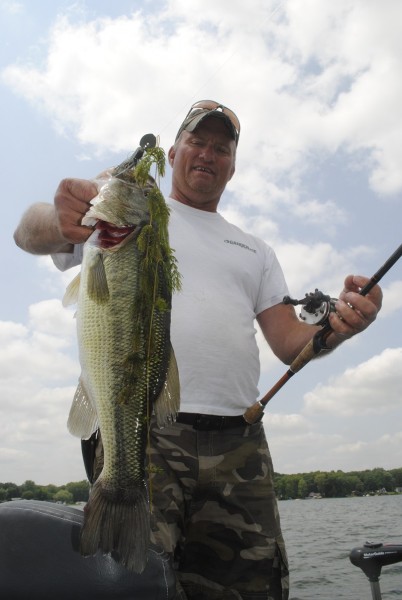Fish Michigan’s Inland Lakes Now
Bob Gwizdz 07.20.15

No one seems to really know how many inland lakes there are in Michigan. Estimates typically run in the 9,000 range. But if you consider anything over one acre a lake (something most of us would call a pond), there are more than twice that many. But suffice it to say that the state that enjoys Great Lakes waters on six sides—all three sides of two separate peninsulas—has no shortage of water inland either.
The Great Lakes, of course, account for more than a fifth of the world’s fresh surface water. So it’s only natural that when people think of Michigan fishing, they equate it with Great Lakes and connecting waters (notably Lake St. Clair and the Detroit River). That’s especially so because of the outstanding fisheries those waters provide. But on any given day, there are many, many more anglers plying inland lakes than fishing Great Lakes waters. And they’re generally enjoying some pretty good fishing, too.
Michigan boasts lakes from border to border that vary significantly in character, from small, shallow, and weedy pools to large deep, clear, rocky basins. To illustrate how varied Michigan lakes really are, consider Houghton Lake and Higgins Lake, just a long cast distant from each other, two-thirds of the way up the Mitten in Roscommon County. Houghton Lake, the state’s largest inland lake at more than 20,000 acres, is primarily shallow and weedy and is known for its walleye, bass, and pike fisheries as well as its panfish (bluegills, pumpkinseeds, and crappie) populations. Higgins Lake, on the other hand, is 9,900 acres with mostly rocky and sandy bottom and is known for its lake trout, rainbow trout, whitefish and yellow perch fishing. The two are as different as night and day.
Virtually all of the state’s rivers have impoundments on them that have created lakes that are largely celebrated for bass and walleye but offer good panfishing, too. They can be found everywhere from metropolitan Detroit to the western Upper Peninsula. Some are quite sizable, others are small, and they vary as much in characteristics as the natural lakes.
The 20 largest lakes in Michigan are found in the northern part of the state, from Houghton Lake north into the Upper Peninsula. These bodies of water range from shallow and cool to deep and cold. Some, thanks to stocking programs by the Department of Natural Resources (DNR), are managed to provide trout fishing opportunities while still maintaining their natural warm-water fish communities (bass, walleye, and panfish). The fisheries guys refer to these “two-story lakes,” but they are not exclusive to Northern Michigan.
So where do you start? Just about anywhere. There is nowhere in Michigan where you are more than an hour’s drive from a lake and the vast majority offer public access. The DNR’s Michigan Recreational Boating Information System lists more than 1,300 boat ramps and there are many, many more that aren’t on the list. The DNR maintains lists of the state’s Better Fishing Waters (as named by the local fisheries biologists) as well, that can be cross-referenced by county or species. You can start close to home or go on a road trip in search of your desired species; the fishing potential is limitless.

Bass are America’s premier game fish these days and Michigan is blessed with outstanding fishing for both largemouths and smallmouths. Generally speaking, the farther north you go the more smallmouth bass predominate, while largemouths are more common in Southern Michigan. But there are plenty of exceptions to the rule and plenty of lakes that boast outstanding populations of both. If you check the DNR’s better fishing waters, you’ll find 73 counties (of 83 in the state) with lakes listed for largemouths, 71 counties for smallies. And thanks to changes in regulations, anglers can now pursue bass 365 days a year (it used to be that anglers couldn’t target bass until the last Saturday in April and they went off-limits after January 1). New this year, anglers are allowed to catch and immediately release bass year-round.
Anglers who are primarily interested in trophy fishing can use the DNR’s Master Angler Award program to identify lakes that produce outstanding specimens. Of the 35 Master Angler largemouths documented by the DNR last year (a minimum of 22 inches or six pounds), 34 came from inland waters.
But for anglers who are not concerned with trophy fishing, but simply want to catch a few fish for fun or food, there are few opportunities more widespread than bluegills. Found in virtually all the lakes of Michigan, bluegills can provide countless hours of enjoyment to everyone from the most seasoned angler to the pure beginner. And there’s no better place to chase them than on some of the smaller inland lakes in Michigan.
And when it comes to table fare, there are few palate-pleasers that can surpass a platter of fresh Michigan bluegills.
For more information on Michigan fishing go to michigan.org. Click here to purchase a Michigan fishing license online.
This article was produced in partnership with Pure Michigan.

